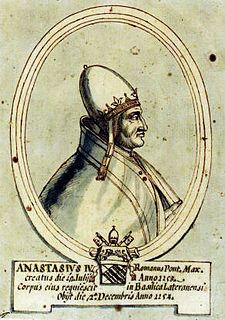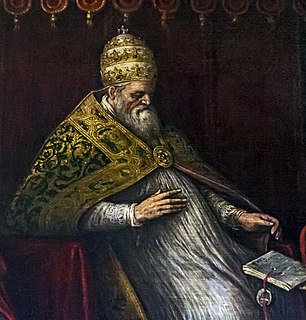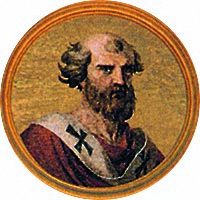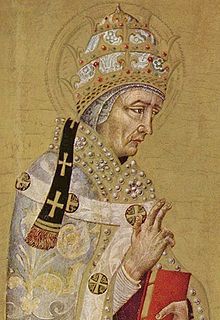
Pope Anastasius IV, born Corrado Demetri della Suburra, was Pope from 8 July 1153 to his death in 1154. He is the last pope to take the name "Anastasius" upon his election.

Pope Honorius II, born Lamberto Scannabecchi, was Pope from 21 December 1124 to his death in 1130.

Pope Honorius III, born as Cencio Savelli, was head of the Catholic Church and ruler of the Papal States from 18 July 1216 to his death in 1227.

Pope Celestine II, born Guido di Castello, was head of the Catholic Church and ruler of the Papal States from 26 September 1143 to his death in 1144. He is the first pope mentioned in the prophecy of Saint Malachy.

Pope Celestine V, born Pietro Angelerio, also known as Pietro da Morrone, Peter of Morrone, and Peter Celestine, was pope for five months from 5 July to 13 December 1294, when he resigned. He was also a monk and hermit who founded the order of the Celestines as a branch of the Benedictine order.

Pope Callixtus II or Callistus II, born Guy of Burgundy, was pope of the western Christian church from 1 February 1119 to his death in 1124. His pontificate was shaped by the Investiture Controversy, which he was able to settle through the Concordat of Worms in 1122.

Pope Innocent II, born Gregorio Papareschi, was Pope from 14 February 1130 to his death in 1143. His election was controversial and the first eight years of his reign were marked by a struggle for recognition against the supporters of Antipope Anacletus II. He reached an understanding with Lothair II, Holy Roman Emperor who supported him against Anacletus and whom he crowned King of the Romans. Innocent went on to preside over the Second Lateran council.

The Western Schism, also called Papal Schism, Great Occidental Schism and Schism of 1378, was a split within the Catholic Church lasting from 1378 to 1417 in which two, by 1410 three, men simultaneously claimed to be the true pope, each excommunicated one another. Driven by politics rather than any theological disagreement, the schism was ended by the Council of Constance (1414–1418). For a time these rival claims to the papal throne damaged the reputation of the office.
Honorius II, born Pietro Cadalo, was an antipope from 1061 to 1072. He was born at Verona and became bishop of Parma in 1046. He died at Parma in 1072.

Gregory VIII, born Mauritius Burdinus, was antipope from 10 March 1118 until 22 April 1121.

A papal name or pontificial name is the regnal name taken by a pope. Both the head of the Catholic Church, usually known as the Pope, and the Pope of the Coptic Orthodox Church of Alexandria choose papal names. As of 2013, Pope Francis is the Catholic Pope, and Tawadros II or Theodoros II is the Coptic Pope. This article discusses and lists the names of Catholic Popes; another article has a list of Coptic Orthodox Popes of Alexandria.

The papal election of 1061 was held on 30 September 1061 in San Pietro in Vincoli in Rome, following the death of Pope Nicholas II. In accordance with Nicholas II's bull, In Nomine Domini, the cardinal bishops were the sole electors of the pope for the first time in the history of the Roman Catholic Church. Bishop Anselmo de Baggio of Lucca, a non-cardinal and one of the founders of the Pataria, was elected Pope Alexander II and crowned at nightfall on 1 October 1061 in San Pietro in Vincoli Basilica because opposition to the election made a coronation in St. Peter's Basilica impossible.

The papal conclave of 1294 was convoked in Naples after the resignation of Pope Celestine V on 13 December 1294. Celestine V had only months earlier restored the election procedures set forth in the papal bull Ubi periculum of Pope Gregory X, which had been suspended by Pope Adrian V in July 1276. Every papal election since then has been a papal conclave. It was the first papal conclave held during the lifetime of the preceding pontiff, an event not repeated until the papal conclave of 2013 following the resignation of Pope Benedict XVI.
Oderisio di Sangro - Italian Benedictine and cardinal, of the family of the counts of Marsi. He joined the order of St. Benedict at the abbey of Montecassino at a young age. About 1112 Pope Paschalis II created him cardinal-deacon of S. Agata; as such, he participated in the papal election of 1118. In 1123 he was elected abbot of Montecassino. Three years later he was deposed as abbot due to personal conflict with Pope Honorius II (1124–30). After the double papal election of 1130 he joined the obedience of Antipope Anacletus II and subscribed his bulls issued on February 8, 1131, and on March 10 of an uncertain year (1135–37).
Pietro Senex was Cardinal-Bishop of Porto from 1102 until his death.

The papal election of 1143 followed the death of Pope Innocent II and resulted in the election of Pope Celestine II.

The papal election of 1144 followed the death of Pope Celestine II and resulted in the election of Pope Lucius II.
Gregorio Tarquini was an Italian cardinal of the Roman Catholic Church. Born in Rome, he was created cardinal deacon of Sts. Sergio e Bacco in December 1122. He participated in five papal elections: those of 1124, 1130, 1143, 1144 and 1145.

The papal election of 1124 took place after the death of Pope Callixtus II and chose Pope Honorius II as his successor.















